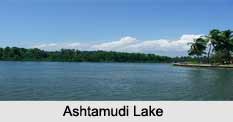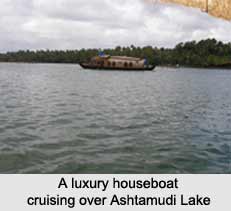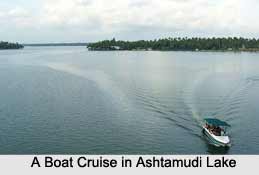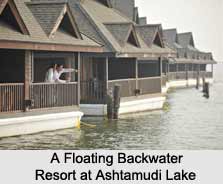 Ashtamudi Lake is a prominent and premier backwater lake in the Kollam district of Kerala. It possesses a distinct wetland ecosystem and an octopus or palm-shaped water body, second largest in the state, only behind the famous Vembanad estuary ecosystem. It is called the gateway to the backwaters of Kerala and is popular for its houseboats and backwater resorts.
Ashtamudi Lake is a prominent and premier backwater lake in the Kollam district of Kerala. It possesses a distinct wetland ecosystem and an octopus or palm-shaped water body, second largest in the state, only behind the famous Vembanad estuary ecosystem. It is called the gateway to the backwaters of Kerala and is popular for its houseboats and backwater resorts.
Etymology of Ashtamudi Lake
Ashtamudi Lake derives its name from its shape, having eight prominent arms or channels branching out, like that of a palm tree or an octopus. "Ashtamudi` means eight-coned ("Ashta" means eight; "mudi" means coned) in the local Malayalam language.
Stretch of Ashtamudi Lake
Ashtamudi Lake feeds on the Kallada River, which is formed by the confluence of Kulathupuzha, Chenthurnipuzha and Kalthuruthipuzha rivers, in the Thiruvananthapuram district of Kerala. After traversing a distance of 121 kilometres, the river discharges into the Ashtamudi Lake. The arms of 16 kilometre long Ashtamudi Lake confluence at Neendakara port near Kollam, entering into the Lakshadweep Sea, part of the Arabian Sea.
Multifarious Attractions in and around Ashtamudi Lake
The Ashtamudi Lake offers a melange of natural and recreational attractions.
Floral Attractions in Ashtamudi Lake
Being the prime backwater destination and wetland in the state of Kerala, the Ashtamudi Lake houses a myriad variety of floral species. Along both its banks and backwater canals, coconut groves and palm trees interspersed with towns and villages are seen. Mangroves Avicennia officinalis, Brugiera gymnorrhiza and Sonneratia caseolaris are found in the estuary. 43 species of marshy and mangrove associates including two endangered species Syzygium travencoricum, about only 200 in number and Calamus rotang have also inhabited the wetland. The threat to these endangered species lies mainly in the draining off of the wetlands and conversion into paddy fields. This range of flora in the Ashtamudi Lake enhances its lushness and scenic beauty.
Avifaunal Attractions in Ashtamudi Lake
Ashtamudi Lake is home to 57 avifaunal species, of which 6 are migratory and 51 residents. There are reportedly 40 species of wetland-dependent birds, of which 45% are long distance migratory ones. Terns, plovers, cormorants and herons are the most abundant of these.
45 species of insects have been identified in the lake, out of which there are 26 species of Butterfly. 29 zooplankton species have been found, in addition to 9 phytoplankton species in the lake"s water body.
Aqua-faunal Attractions in Ashtamudi Lake
97 species of aquatic animals have been reported to inhabit the lake, including marine, estuarine, estuarine riverine and estuarine marine ones. It is also home to unique species of copepod, all species of palaemonid prawns, edible crabs, black clams and varied fish species.
Island Attractions in Ashtamudi Lake
The Munroe Island is a cluster of eight little islands in the lake. Also, the Chavara South Island within the lake houses a small village, at 14 kilometres distance from Kollam. Thekkumbhagam Island on the banks of the lake also houses a village, offering the rural countryside appeal with nature"s exquisiteness.
Recreational and Tourism Attractions in Ashtamudi Lake
The nature"s epitome Ashtamudi Lake is famous for its luxury houseboats and backwater resorts.
Boat rides and houseboat cruises across the lake are offered by the District Tourism Promotion Council (DTPC), Kollam and Kollam Boat Club. The trip from Kollam to Alappuzha is one of the most popular and longest backwater cruises in Kerala. The 8-hour journey offers tourists an intimate connection to the backwater richness of Ashtamudi Lake, through winds, canals and island bound villages along with access to other towns and villages along the route. Luxury houseboats operating and "cheena vala" (Chinese fishing nets) used by local fishermen are sighted while taking a tour along the lake.
An ancient thousand year old temple is located here, along with a church that is 200 years old.
Trade and Livelihood Relevance of Ashtamudi Lake
Kollam, formerly Quilon, is an important historic port city on the banks of Ashtamudi Lake. The lake and Kollam city along with the Neendakara port are important routes for transport for trade and commerce in the Kerala state, in cashew trading and processing and marine products industry. The lake is also an important means of livelihood from fishing, coconut husk retting for production of coir and inland navigation, for the locals.
Clams found in the estuary are of export quality, and the estuary is stated as the second biggest fish landing site after the Vembanad estuary while also being a source of livelihood for thousands of fishermen.
The Chavara South Island is mineral rich and a number of extraction factories have come up there. Titanium and other minerals are exported from there, and the discharge from factories does pollute the lake waters.
Literary Relevance of Ashtamudi Lake
The nature-gifted Ashtamudi Lake and its shores have been a source of inspiration for artists, writers and poets. Many works of the renowned poet Thirunalloor Karunakaran, born and brought up on the banks, have the lake as the subject. The village in Thekkumbhagom Island is where the first Malayalam epic poetry "Ramachandravilasam" was composed by poet Azhakath Padmanabha Kurup.
Deterioration and subsequent Restoration plans for Ashtamudi Lake
The Ashtamudi Lake has naturally been a victim of trade and fishing activities prevalent in the area. The intense anthropogenic pressure, oil spills from fishing boats and industries, encroachments and development through conversion and destruction of natural habitats causing shrinking of fragile zones, untreated sewage with excess disposal of industrial waste and human excreta are the causes behind the substantial deterioration of lake"s environment. Kanjiracode creek, one arm of the Ashtamudi Lake at its south-east has suffered severe extinction due to dumping of waste and clay into the lake by a state public sector unit. This destruction has affected the livelihood of local people and fishermen, dependent on species of fish that have disappeared.
The Asia Development Assistance Facility of the New Zealand Government carried out a study to draw up a plan for sustainable management of the estuary, ecosystem development. The plan encompasses meticulous strategies of improving sanitation, preventing pollution, protection of shores through mangrove afforestation, restricted mining, preservation of estuaries, sustenance of fish species and by and large promotion of ecotourism and better inland navigation services. The lake has the scope of becoming a marine bioreserve with better implementation of environmental measures and conservation of biodiversity inhabiting it. Ashtamudi Wetland was recognised as wetland of international importance, by the Ramsar Convention for conservation and sustainable utilization of wetlands. In November 2014, the lake was recognised for sustainable clam fishing.
Getting to Ashtamudi Lake
Ashtamudi Lake can be accessed from its entry city Kollam.
By Air: The Trivandrum International Airport is 70 kilometres away from the lake.
By Rail: The nearest railhead is the Kollam Junction at 15 kilometres via Thekkumbhagam road. Boat jetty about 3 kilometres from the station operate to the lake and all villages in the backwater"s canals.
By Road: The National Highway 47 (NH 47) passes through the lake"s periphery from Kollam. It also runs along other locations of the banks of the lake from Thiruvananthapuram.
Best Season to visit Ashtamudi Lake
The Ashtamudi Lake is a premier monsoon getaway destination. It can be visited during the appealing rainy season between August and October, and also during winters from November to February, when the temperatures are pleasantly cool.















